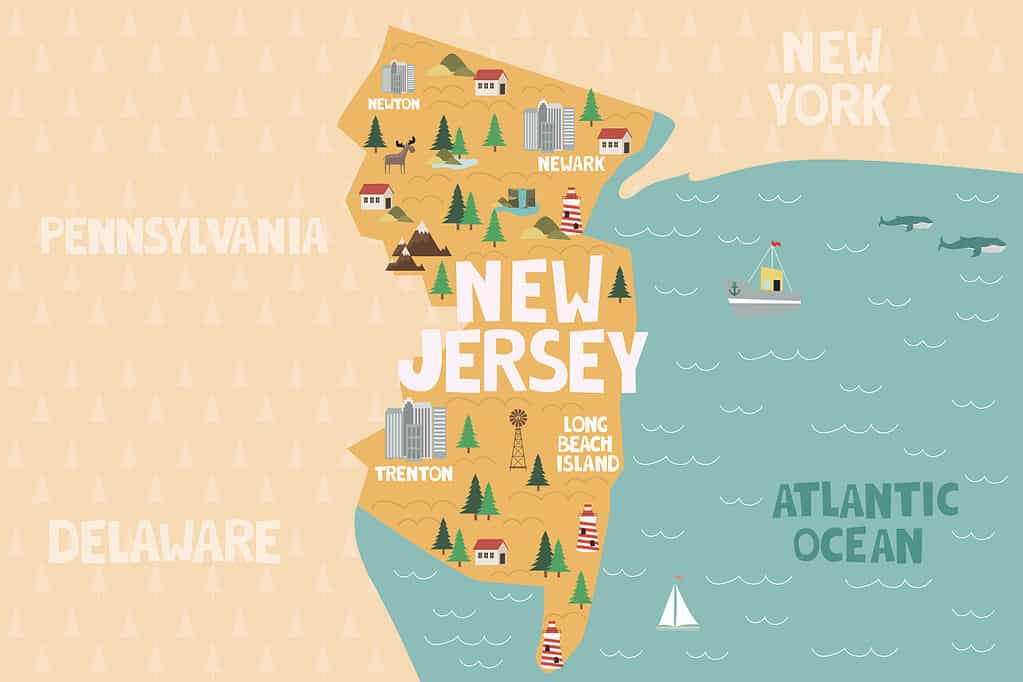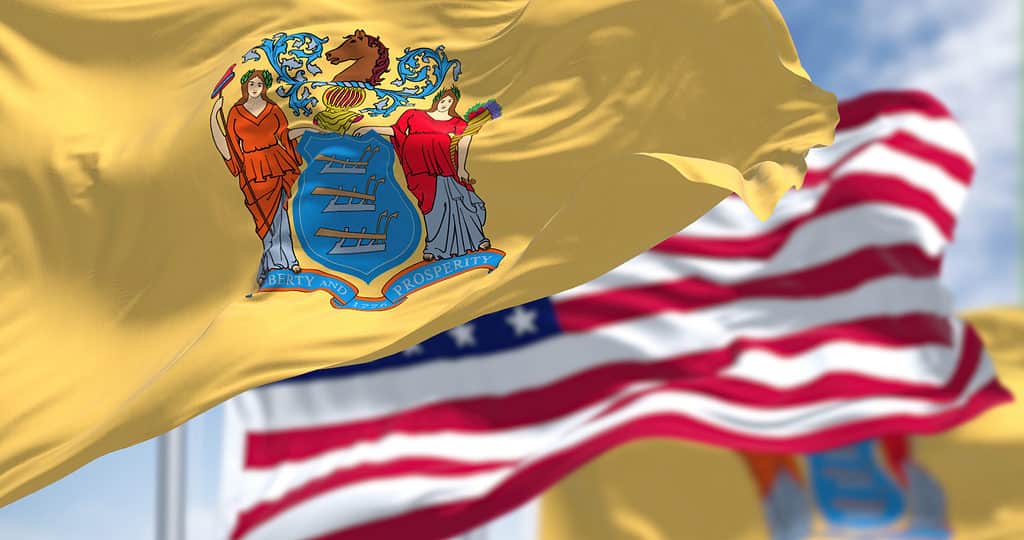New Jersey is northeastern state that has a rich history starting long before European settlers stepped foot on the land. Are you curious about the flag of New Jersey and the state’s general history? Keep reading to discover the history, meaning, and symbolism behind New Jersey’s flag!
Where Is New Jersey?
New Jersey is a state in the United States. It borders the state of New York, Pennsylvania, the Atlantic Ocean, and Delaware. It is very populated with an estimated population of 11 million. Interestingly, while 11 million people are living in New Jersey, the state is the 5th smallest in the country. Its total surface area is 8,722.58 square miles. New Jersey is beautiful, with lots to see including mountains, hills, and beaches. About 14.9% of New Jersey’s total surface area is water.

New Jersey is bordered by Delaware, Pennsylvania, New York, and the Atlantic Ocean.
©iStock.com/BonneChance
The History of New Jersey
This section will only briefly discuss the history of New Jersey starting with Paleo-Indians and Native Americans. About 15,000 years ago, the land we know now as northern New Jersey was uninhabitable with a thick sheet of ice. Paleo-Indians settled in the area of New Jersey around 13,000 B.C. after the Wisconsin Glacier melted. They soon moved away when food was scarce. While there’s always been movement in the region, it wasn’t until the year 1,000 that a group settled for a long time. The Lenape moved from the Mississippi River to New Jersey.
The first European settlers in New Jersey were the French. Giovanni da Verrazzano in 1524 reached and explored New Jersey’s coast. Nearly a century later, Sir Henry Hudson sailed for the Dutch East India Company and explored Delaware, New York, New Jersey, and Raritan bay. It was then named the New Netherlands by a Dutch private trader, Adriaen Block. The Dutch weren’t the only ones settling in New Jersey though. In part of southwestern New Jersey, the swedes settled, naming the area New Sweden. Less than a century later and England owned New Jersey.
New Jersey was one of the first colonies and many of the settlers sided with Great Britain, including slaves that were promised freedom. Despite this, New Jersey was the third state to ratify the constitution. In the next two centuries, New Jersey saw a lot of movement and participated in the Mexican-American war, World War 1, and World War 2. New Jersey’s history is rich and long, this is just a brief account so we can further understand the meaning and symbolism behind the state’s flag.
History of New Jersey’s Flag
New Jersey’s flag is one of the oldest state flags in the United States and has seen little change since it was first introduced. Pierre Eugene du Simitiere designed the flag in 1777. Although it was designed in the 1700s, the flag wasn’t officially accepted as the state’s flag until May 11, 1896. It was slightly modified in 1928. The state’s government defined the flag’s colors in 1965.
What Does New Jersey’s Flag Look Like?
New Jersey’s flag has a simple buff-colored background with its coat of arms in the center. According to the system designed by the Color Association of the United States, the color buff is designed as Cable No. 65015. The coat of arms displays two women, Liberty and Ceres. Liberty stands on the left and holds a staff with a stylized Phrygian cap. Ceres to her right holds an overflowing cornucopia. In the center between the two female figures is a blue shield with three plows. Above the shield are a forward-facing helmet and the head of a horse. Underneath the feet of the two women is a streamer with the State Motto of New Jersey, “Liberty and Prosperity” along with the year of statehood, 1776.

The flag of New Jersey presents the state’s coat of arms against a buff-colored background.
©Wangkun Jia/Shutterstock.com
Meaning and Symbolism of New Jersey’s Flag
Now that you know the state and flag’s history and what the flag looks like, we can dive into the meaning and symbolism. Most of the meaning comes from the centerpiece, the coat of arms. However, the reason the base of the flag is buff is George Washington ordered that the uniform coats of the New Jersey Continental Line have buff facings. The uniforms were also blue, which is used throughout the flag.
The two female figures stand for the state motto, “Liberty and Prosperity”. Agriculture was very important for the state, which is reflected in the three plows in the shield. This fits New Jersey’s nickname, the Garden State. Interestingly, in 2016 NJ Advance Media and NJ.com ran a contest to choose a new flag for New Jersey. While a winner was declared, nothing has legally changed. Those interested in changing the flag are still trying to gain the attention of legislators.

The flag of New Jersey pays tribute to the state’s agricultural tradition.
©iStock.com/rarrarorro
Where Is New Jersey Located on a Map?
New Jersey is situated along the Eastern Seaboard. It is south and southeast of the state of New York, and east of Pennsylvania and Delaware. The Atlantic Ocean lies to its east and south.
The photo featured at the top of this post is © iStock.com/Kamlesh Suthar
Sources
- Official site of the state of New Jersey, Available here: https://www.state.nj.us/nj/about/symbols/#:~:text=The%20New%20Jersey%20State%20Flag,regiments%20during%20the%20Revolutionary%20War.
Thank you for reading! Have some feedback for us? Contact the AZ Animals editorial team.






